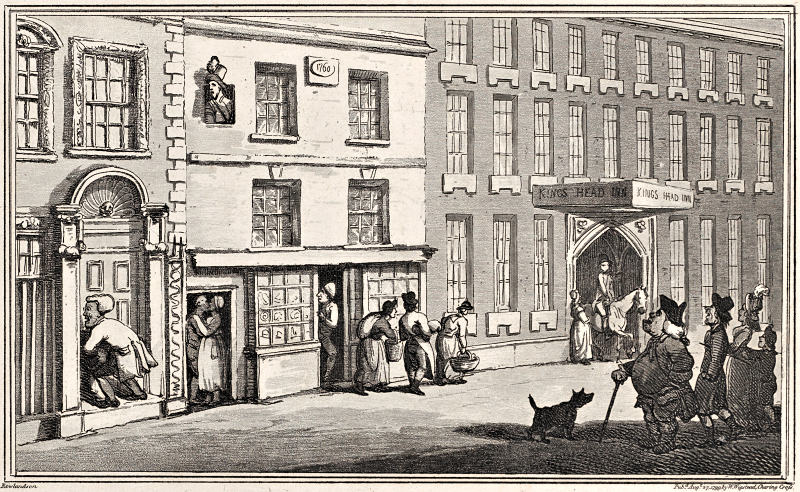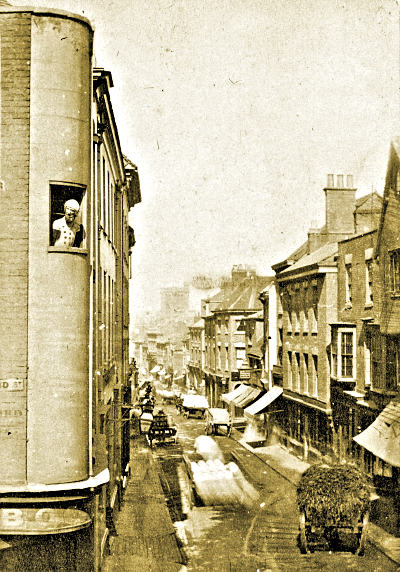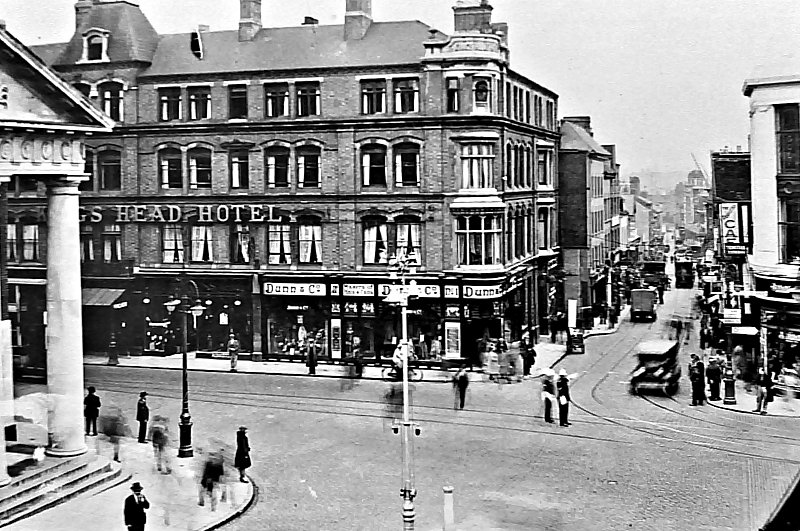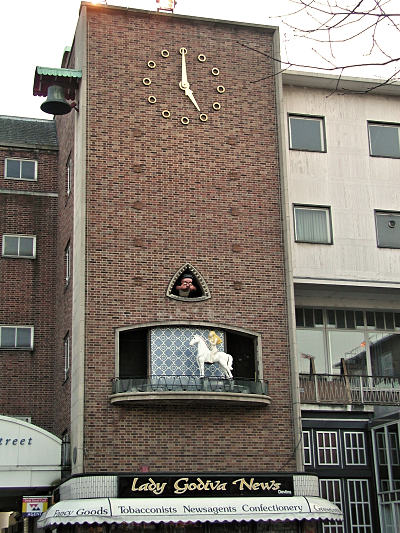Kings Head Hotel, 3 Smithford Street
| Alternative Addresses: | Hertford Street | ||
| These premises have been known by different names during their history: | FROM | TO | NAME |
| Kings Head Inn | |||
| Kings Head Hotel | |||
| Kings Head Bar | |||
 Before Hertford Street was built, the King's Head was simply part of a terrace of shops in Smithford Street, as this Rowlandson drawing of 1799 testifies. The building of Hertford Street left Thomas Sharp's shop as the corner property, with Peeping Tom looking out from a niche on the corner. When the King's Head was enlarged in the late 1870s it incorporated the shop, so Tom found himself peeping out from the corner niche of the new King's Head, without having moved!  The photograph on the right was taken around 1860 by Joseph Wingrave only around a decade or two after the invention of the camera. Wingrave owned a chemist shop in High Street, and was responsible for virtually all of the oldest photos of Victorian Coventry. All who used this cross-roads, of course, were looked upon by Coventry's own legend - Peeping Tom. Here he peeps out from the corner window of the King's Head. The street running off to the west is Smithford Street, which was once half of Coventry's main east-west thoroughfare. The tower of St. John's church can be seen at the far end of the Street.
An inn probably stood here from the middle ages: 15th century cellars were discovered in the 1930s. In 1532 we have a rental by Trinity Guild to William Lynde for the "Kynges Hed". In the 18th century coaches left from the King's Head every evening at 11.30 p.m. to reach London at 4.00 the following morning. Until 1812, when Hertford Street became the main route to the south, Smithford Street carried the main traffic, and the King's Head was one of a number of large inns lining its route, including the Green Dragon, Bull, and the Ram, as shown on Bradford's Survey of 1748-49.
Throughout the 18th century 'ordinaries', that is set dinners, were held at the King's Head following Coventry Races. In 1756 General Stewart's 37th Regiment of Foot were billeted in Coventry and the King's Head took more than anywhere else - eight officers and six men - which implies that it was the largest premises in the city.
During the 19th century the inn had its quota of famous visitors. In 1802 Lord Nelson, accompanied by Sir William and Lady Hamilton and others, alighted at the King's Head unannounced, the mayor and populace rushing to greet them. In 1808 the exiled Louis XVIII of France stayed there, as did the Duke of Wellington in 1823.
In 1812 Hertford Street was laid out to relieve congestion in the very narrow Greyfriars Lane. The premises on the corner of Hertford Street and Smithford Street became a hatter's shop, owned by antiquarian Thomas Sharp, and it is here we meet a familiar local figure, Peeping Tom. The statue used as Peeping Tom has been around in Coventry for over three and a half centuries but started out life in the guise of a much nobler figure... St. George! He is a carved wooden figure in Elizabethan armour, who has been used to represent Peeping Tom since at least 1659, when he looked out of a window in Cross Cheaping. In 1678 he was moved to Greyfriars Lane, and in 1775 to the shop in Smithford Street.
In the 19th century the King's Head Inn was the election headquarters of the Tory Party. At this time Coventry was a 'closed council' and very few citizens had the right to vote. As there were so few voters, both Tories and Whigs used violence to try to coerce the 'correct' result. In the election of 1832 there was mass fighting, and the Tory supporters retreated to the Kings Head, which was said to have resembled a slaughterhouse. The event became known as the 'Bloody Tenth'. This resulted in the Municipal Corporations Act of 1835, under which voting was extended to all freemen and property owners. Coventry lost its status as a County, and political debate replaced mass brawling.
In 1853 a company was formed to build a corn exchange which until then had been held in the open in Broadgate. The King's Head was purchased for £6,500 and part of the outbuildings facing Hertford Street was pulled down and replaced with the new Corn Exchange.
In 1863 the Kings Head was commemorated in verse (doggerel might be more accurate):
When next at Coventry I stopped to dine
At the Kings Head, a house ne'er known to fail
In Worcester cyder and in Shropshire ale.
The cutlets came, rich and well done and smoking:
The host came too, a man much given to joking:
And read of old a wondrous tale.
Interesting that they were selling Worcester cider and Shropshire ale at that time! The photograph on the right was taken around 1860 by Joseph Wingrave only around a decade or two after the invention of the camera. Wingrave owned a chemist shop in High Street, and was responsible for virtually all of the oldest photos of Victorian Coventry. All who used this cross-roads, of course, were looked upon by Coventry's own legend - Peeping Tom. Here he peeps out from the corner window of the King's Head. The street running off to the west is Smithford Street, which was once half of Coventry's main east-west thoroughfare. The tower of St. John's church can be seen at the far end of the Street.
An inn probably stood here from the middle ages: 15th century cellars were discovered in the 1930s. In 1532 we have a rental by Trinity Guild to William Lynde for the "Kynges Hed". In the 18th century coaches left from the King's Head every evening at 11.30 p.m. to reach London at 4.00 the following morning. Until 1812, when Hertford Street became the main route to the south, Smithford Street carried the main traffic, and the King's Head was one of a number of large inns lining its route, including the Green Dragon, Bull, and the Ram, as shown on Bradford's Survey of 1748-49.
Throughout the 18th century 'ordinaries', that is set dinners, were held at the King's Head following Coventry Races. In 1756 General Stewart's 37th Regiment of Foot were billeted in Coventry and the King's Head took more than anywhere else - eight officers and six men - which implies that it was the largest premises in the city.
During the 19th century the inn had its quota of famous visitors. In 1802 Lord Nelson, accompanied by Sir William and Lady Hamilton and others, alighted at the King's Head unannounced, the mayor and populace rushing to greet them. In 1808 the exiled Louis XVIII of France stayed there, as did the Duke of Wellington in 1823.
In 1812 Hertford Street was laid out to relieve congestion in the very narrow Greyfriars Lane. The premises on the corner of Hertford Street and Smithford Street became a hatter's shop, owned by antiquarian Thomas Sharp, and it is here we meet a familiar local figure, Peeping Tom. The statue used as Peeping Tom has been around in Coventry for over three and a half centuries but started out life in the guise of a much nobler figure... St. George! He is a carved wooden figure in Elizabethan armour, who has been used to represent Peeping Tom since at least 1659, when he looked out of a window in Cross Cheaping. In 1678 he was moved to Greyfriars Lane, and in 1775 to the shop in Smithford Street.
In the 19th century the King's Head Inn was the election headquarters of the Tory Party. At this time Coventry was a 'closed council' and very few citizens had the right to vote. As there were so few voters, both Tories and Whigs used violence to try to coerce the 'correct' result. In the election of 1832 there was mass fighting, and the Tory supporters retreated to the Kings Head, which was said to have resembled a slaughterhouse. The event became known as the 'Bloody Tenth'. This resulted in the Municipal Corporations Act of 1835, under which voting was extended to all freemen and property owners. Coventry lost its status as a County, and political debate replaced mass brawling.
In 1853 a company was formed to build a corn exchange which until then had been held in the open in Broadgate. The King's Head was purchased for £6,500 and part of the outbuildings facing Hertford Street was pulled down and replaced with the new Corn Exchange.
In 1863 the Kings Head was commemorated in verse (doggerel might be more accurate):
When next at Coventry I stopped to dine
At the Kings Head, a house ne'er known to fail
In Worcester cyder and in Shropshire ale.
The cutlets came, rich and well done and smoking:
The host came too, a man much given to joking:
And read of old a wondrous tale.
Interesting that they were selling Worcester cider and Shropshire ale at that time!
 This photo was taken from the corner of High Street and Broadgate.
The old inn was demolished in the 1870s and a new King's Head extending round the corner into Hertford Street was opened by Christmas 1879 (above). This is when the figure of Peeping Tom acquired its niche on the fourth floor. It is probably also the date when the King's Head Inn became the King's Head Hotel. The ground floor was occupied by Dunns Outfitters, so the corner became known as 'Dunns corner'. We have a copy of a brochure for the King's Head Hotel c1880. It states, 'This commodious Hotel, which has been recently rebuilt and greatly enlarged, from plans furnished by Mr. George Taylor, Architect of the City, and erected by Mr. James Marriott, Contractor, is now open for the reception of guests'.
The Public Luncheon Bar was opened on 20th December 1879 with bar and cabinet fittings of substantial character and elaborate design, the work of Samuel Mason of Birmingham. The windows were by W. G. Fretton of Coventry. There was a wholesale wine and spirits department and the King's Head Tap stood on Vicar Lane with a bar and smoke room suitably furnished and an upstairs room for clubs or meetings. This must be the KINGS HEAD BAR, which we have given a separate page.
In 1909 the hotel was acquired by Max Meinhardt, a man with a somewhat Germanic name, so it is not surprising, given the climate of the day, that from 1911 the licensee is always given as 'The King's Head Hotel Co. Ltd'.
 Following the end of the Great War throughout Europe, as soldiers returned home and were demobbed they found themselves unemployed in countries with financial problems and raging inflation. There was widespread rioting in Britain and revolution abroad. In July 1919 Peace Processions were held in Britain. On Saturday 19th July, following the Peace Procession in Coventry, at 11.30 p.m. a mob appeared in Broadgate and attacked Dunn's shop on the ground floor of the King's Head and also the Black Cat Cafe and Restaurant, in the belief that they were both owned by Germans. The Black Cat was in fact owned by a Mr. Heinmann, who advertised in the Midland Daily Telegraph that he was Danish and married to an Englishwoman. It seems that Max Meinhardt could issue no such assurance and the King's Head was again attacked on Sunday night. The rioting spread to the city centre in general, including the Talbot and the City Hotel. So on Monday the Lord Mayor issued a curfew ordering all people off the streets after 9 p.m., which had the desired effect and peace was restored. So ended one of the darker episodes in Coventry's history.
In 1934 Peeping Tom was taken into the hotel. The intention was to place a copy in the outside niche whilst the original was restored. This never happened, and the Luftwaffe did what the rioters had failed to do: it destroyed the hotel in the blitz of 1940. In its place stands Broadgate House. Tom survived the hotel and later appeared in the replacement for the King's Head - the Hotel Leofric. He ended up in a glass case in Cathedral Lanes, but he outlived the King's Head, the blitz, and the Hotel Leofric too!
A different Peeping Tom is now not far away from the window of that Hotel; an animated one watches over Lady Godiva as she parades around the "Godiva Clock", on the hour, every hour, in the 1950s rebuilt Broadgate. The accurate clock movement inside was salvaged from the old Market Tower, which dominated the city centre skyline until its demolition after the Second World War. Following the end of the Great War throughout Europe, as soldiers returned home and were demobbed they found themselves unemployed in countries with financial problems and raging inflation. There was widespread rioting in Britain and revolution abroad. In July 1919 Peace Processions were held in Britain. On Saturday 19th July, following the Peace Procession in Coventry, at 11.30 p.m. a mob appeared in Broadgate and attacked Dunn's shop on the ground floor of the King's Head and also the Black Cat Cafe and Restaurant, in the belief that they were both owned by Germans. The Black Cat was in fact owned by a Mr. Heinmann, who advertised in the Midland Daily Telegraph that he was Danish and married to an Englishwoman. It seems that Max Meinhardt could issue no such assurance and the King's Head was again attacked on Sunday night. The rioting spread to the city centre in general, including the Talbot and the City Hotel. So on Monday the Lord Mayor issued a curfew ordering all people off the streets after 9 p.m., which had the desired effect and peace was restored. So ended one of the darker episodes in Coventry's history.
In 1934 Peeping Tom was taken into the hotel. The intention was to place a copy in the outside niche whilst the original was restored. This never happened, and the Luftwaffe did what the rioters had failed to do: it destroyed the hotel in the blitz of 1940. In its place stands Broadgate House. Tom survived the hotel and later appeared in the replacement for the King's Head - the Hotel Leofric. He ended up in a glass case in Cathedral Lanes, but he outlived the King's Head, the blitz, and the Hotel Leofric too!
A different Peeping Tom is now not far away from the window of that Hotel; an animated one watches over Lady Godiva as she parades around the "Godiva Clock", on the hour, every hour, in the 1950s rebuilt Broadgate. The accurate clock movement inside was salvaged from the old Market Tower, which dominated the city centre skyline until its demolition after the Second World War.One of the most popular pub names. The head usually shown on signs is that of Henry VIII but at least eight other monarchs have been shown. Sometimes there are different kings on each side of the sign board. | |||
LICENSEES:1532 - 1533 William Lynde 1763 - 1772 Richard Richards (died 1772) 1772 - 1803 Thomas Soden (also Post Master, died 1809) 1805 - 1809 William Carter (died 1834) 1817 - 1841 Thomas Carter 1841 - 1848 James Williamson 1848 - 1851 Charles Sabin 1861 William P. Merry 1868 - 1874 Miss Mary Ann Sabin 1881 A. Prior 1890 Amelia Ann Balderson 1890 George Fox Spencer 1890 - 1891 Miss Scoley 1893 - 1896 G. F. Spencer 1899 Charles Edwards Newitt 1899 Andrew Thomson (music license also granted) 1903 W. Baker 1905 T. C. Bird 1909 Max Otto Meinhardt 1911 - 1940 Kings Head Hotel Co. Ltd | |||
OWNERS:1532 - 1533 Trinity Guild 1703 - 1704 E. Owen senior 1703 - 1704 W. Hethersett & J. Sharpe | |||
 Street plan of 1893 | |||
| Previous page: Kings Head Bar | This page: Kings Head Hotel | Next page: Kings Head Inn |